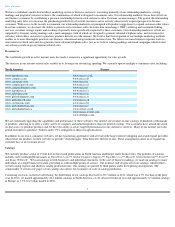CompUSA 2011 Annual Report Download - page 16
Download and view the complete annual report
Please find page 16 of the 2011 CompUSA annual report below. You can navigate through the pages in the report by either clicking on the pages listed below, or by using the keyword search tool below to find specific information within the annual report.
As of December 31, 2011, we have seven distribution centers in Europe which aggregate approximately 287,000 square feet. Six of these, aggregating
approximately 214,000 square feet, are leased; one distribution center of approximately 73,000 square feet is owned by the Company. Our
administrative offices and call centers aggregate approximately 270,000 square feet, of which 193,000 square feet are leased and 77,000 square feet are
owned by the Company.
As of December 31, 2011, we leased administrative offices in Asia of approximately 4,400 square feet.
Please refer to Note 11 to the Consolidated Financial Statements for additional information about leased properties.
Item 3. Legal Proceedings.
The Company and its subsidiaries are involved in various lawsuits, claims, investigations and proceedings including commercial, employment,
consumer, personal injury and health and safety law matters, which are being handled and defended in the ordinary course of business. In addition, the
Company is subject to various assertions, claims, proceedings and requests for indemnification concerning intellectual property, including patent
infringement suits involving technologies that are incorporated in a broad spectrum of products the Company sells. The Company is also audited by (or
has initiated voluntary disclosure agreements with) numerous governmental agencies in various countries, including U.S. Federal and state authorities,
concerning potential income tax, sales tax and unclaimed property liabilities. These matters are in various stages of investigation, negotiation and/or
litigation, and are being vigorously defended.
Although the Company does not expect, based on currently available information, that the outcome in any of these matters, individually or
collectively, will have a material adverse effect on its financial condition or results of operations, the ultimate outcome is inherently unpredictable.
Therefore, judgments could be rendered or settlements entered, that could adversely affect the Company’s operating results or cash flows in a
particular period. The Company routinely assesses all of its litigation and threatened litigation as to the probability of ultimately incurring a liability,
and records its best estimate of the ultimate loss in situations where it assesses the likelihood of loss as probable and estimable.
Audit Committee Investigation and Gilbert Fiorentino
’s Resignation and Settlement and Related Matters.
In January and February 2011 the Company received anonymous whistleblower allegations concerning the Company’s Miami Florida operations
involving the actions of Mr. Gilbert Fiorentino, then the Chief Executive of the Company’
s Technology Products Group. In response to the allegations,
the Company commenced an internal investigation of the whistleblower allegations, which was conducted by the Company’s Audit Committee of the
Board of Directors with the assistance of independent counsel.
On April 18, 2011, following the independent investigation, the Company delivered a Cause Notice to Mr. Fiorentino pursuant to the terms of his
Employment Agreement dated October 12, 2004. The Cause Notice advised Mr. Fiorentino that the Company intended to terminate him for
“Cause” (as defined in the Employment Agreement) at a meeting of its Executive Committee scheduled for May 3, 2011, at which meeting Mr.
Fiorentino and his counsel could appear, and that Mr. Fiorentino was being placed on administrative leave pending the outcome of that meeting. In the
Cause Notice, the Company advised Mr. Fiorentino that the Audit Committee investigation had identified grounds to terminate him for Cause under
his Employment Agreement, and set forth the following findings by the Audit Committee constituting such grounds:
i) Mr. Fiorentino personally removed or caused to be removed from the Company’
s Miami premises product inventory, and/or kept or caused
others to receive at his direction such removed product inventory, without payment to the Company and for his own personal gain;
ii) Mr. Fiorentino caused substantial amounts of Company inventory purchases to be effected through Company credit cards in order to
accrue and/or use “reward points” for his personal benefit and which he improperly converted to his own use;
iii) Mr. Fiorentino caused his mother to be identified as an employee of the Company in positions for which she had no bona fide job
responsibility or function, and caused the Company to pay her a salary and employee benefits, including extended COBRA reimbursements;
and
iv) Mr. Fiorentino engaged in fraudulent “kickback” arrangements with certain of the Company’s vendors, to the detriment of the Company
The Company stated in the Cause Notice that the foregoing activities were in violation of Company policy, the Company’s Corporate Ethics Policy,
his fiduciary duties and applicable law. The amounts involved in the employment of Mr. Fiorentino's mother are small in absolute terms. The
inventory removal constitutes a shortage that is not material for a company the size of Systemax. The credit card reward points scheme involved the
creation, and conversion, of non-monetary assets. The finding involving the vendor overcharge/kickback allegations is not material when compared to
the Company's total inventory spend during the subject period. The Audit Committee’s independent investigation determined that the matters
described above did not have any material impact on our previously reported financial results and were limited to the Company’s Miami operations.
Table of Contents
14
























